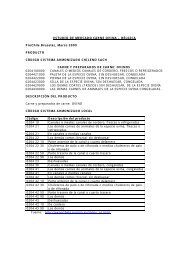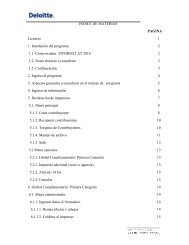Mobile banking A catalyst for improving bank performance - Deloitte
Mobile banking A catalyst for improving bank performance - Deloitte
Mobile banking A catalyst for improving bank performance - Deloitte
Create successful ePaper yourself
Turn your PDF publications into a flip-book with our unique Google optimized e-Paper software.
<strong>Mobile</strong> <strong><strong>bank</strong>ing</strong><br />
A <strong>catalyst</strong> <strong>for</strong> <strong>improving</strong><br />
<strong>bank</strong> per<strong>for</strong>mance
Contents<br />
Introduction — mobile <strong><strong>bank</strong>ing</strong> at the tipping point 1<br />
A confluence of factors 2<br />
The demographics of mobile <strong><strong>bank</strong>ing</strong> 3<br />
Opportunities <strong>for</strong> operational efficiencies 4<br />
Opportunities <strong>for</strong> revenue growth 5<br />
Key challenges in mobile <strong><strong>bank</strong>ing</strong> 7<br />
The future is now 8<br />
<strong>Mobile</strong> <strong><strong>bank</strong>ing</strong> A <strong>catalyst</strong> <strong>for</strong> <strong>improving</strong> <strong>bank</strong> per<strong>for</strong>mance
Introduction — mobile <strong><strong>bank</strong>ing</strong> at the tipping point<br />
Introduction — mobile <strong><strong>bank</strong>ing</strong> at<br />
the tipping point<br />
<strong>Mobile</strong> <strong><strong>bank</strong>ing</strong> is on the cusp of trans<strong>for</strong>mation from a niche service <strong>for</strong> the technologically elite to a<br />
mass-market service demanded by all customer segments.<br />
As <strong>bank</strong>s develop their strategies <strong>for</strong> giving customers access to their accounts through cell phones<br />
and other mobile devices, they should also regard this emerging plat<strong>for</strong>m as a potential <strong>catalyst</strong> <strong>for</strong><br />
generating operational efficiencies and as a vehicle <strong>for</strong> new revenue sources.<br />
Moreover, the Dodd-Frank Wall Street Re<strong>for</strong>m and Consumer Protection Act and other regulatory<br />
changes are trans<strong>for</strong>ming the economics of <strong><strong>bank</strong>ing</strong>, creating additional incentives <strong>for</strong> <strong>bank</strong>s to<br />
serve customers in a better, yet more efficient, manner. Additionally, these new and convenient<br />
products and services provide <strong><strong>bank</strong>ing</strong> institutions with a way to reconnect with their customer base<br />
and regain some of the trust that was lost as a result of the financial crisis.<br />
At the same time, <strong>bank</strong>s must prepare to defend their franchises against threats from not only other<br />
financial institutions, but also mobile carriers, credit card processors, and other non<strong>bank</strong> competitors<br />
that want to help consumers conduct financial transactions wherever they — and their mobile<br />
devices — are.<br />
<strong>Mobile</strong> <strong><strong>bank</strong>ing</strong> A <strong>catalyst</strong> <strong>for</strong> <strong>improving</strong> <strong>bank</strong> per<strong>for</strong>mance 1
A confluence of factors<br />
A confluence of factors<br />
Bankers have been talking about using cell phones as a<br />
channel <strong>for</strong> consumer <strong><strong>bank</strong>ing</strong> almost as long as energy<br />
companies have been trying to make solar power af<strong>for</strong>dable,<br />
but it has taken a confluence of factors to make mobile<br />
<strong><strong>bank</strong>ing</strong> a reality:<br />
Rapid adoption of smartphones<br />
Over the past several years, consumers have made<br />
smartphones their preferred mobile devices. Smartphones<br />
allow users to make calls, send and receive e-mail and text<br />
messages, browse the Web, and per<strong>for</strong>m many other tasks by<br />
downloading free or low-cost software applications or “apps.”<br />
According to published reports, the number of smartphones sold in the United States rose more than<br />
60%, from 26 million in 2008 to 42 million in 2010. Another 25 million consumers are expected to<br />
purchase smartphones by 2012, bringing the total number of units in use to 67 million, or 50% of<br />
market share 1 .<br />
Shifts in consumer preferences<br />
Like automated teller machines “ATMs” and online <strong><strong>bank</strong>ing</strong> services, smartphones are giving<br />
consumers more options. By being able to access account in<strong>for</strong>mation and per<strong>for</strong>m transactions<br />
without requiring access to <strong>bank</strong> branches, ATMs, or computers, consumers are able to “<strong>bank</strong>”<br />
wherever and whenever they want — and they are learning to expect such convenience.<br />
A significant capability build-out<br />
Most large <strong>bank</strong>s have made substantial investments in mobile <strong><strong>bank</strong>ing</strong> capabilities, and smaller<br />
financial institutions are not far behind. In addition, mobile network carriers, credit card processors,<br />
and online personal finance services that allow consumers to aggregate their accounts on a single<br />
Web site or app are among the many non<strong>bank</strong>s jockeying <strong>for</strong> position in this fast-growing space.<br />
Product and service innovation<br />
The mobile channel allows <strong>bank</strong>s to offer customers features they cannot find online, such as<br />
remote check deposit, person-to-person (P2P) payments, and real-time fraud notification. Such<br />
features make mobile <strong><strong>bank</strong>ing</strong> a richer experience and will drive adoption over the next few years.<br />
1 Source Yankee Group as Cited by Internet Retailer, March 2009; eMarketer calculations March 2009<br />
<strong>Mobile</strong> <strong><strong>bank</strong>ing</strong> A <strong>catalyst</strong> <strong>for</strong> <strong>improving</strong> <strong>bank</strong> per<strong>for</strong>mance 2
The demographics of mobile<br />
<strong><strong>bank</strong>ing</strong><br />
The demographics of mobile <strong><strong>bank</strong>ing</strong><br />
<strong>Mobile</strong> <strong><strong>bank</strong>ing</strong> is growing at a fast clip among U.S.<br />
consumers.<br />
From 2005 to 2010, mobile <strong><strong>bank</strong>ing</strong> usage increased at nearly<br />
a 100% compounded annual growth rate i , with most of that<br />
growth occurring after 2007, the year that Apple Inc.<br />
introduced its revolutionary iPhone and App Store.<br />
According to <strong>Deloitte</strong>’s research, approximately 10% of mobile<br />
phone users conduct some <strong><strong>bank</strong>ing</strong> transactions by phone.<br />
Chief among these users are the members of Generation Y,<br />
who were born between 1979 and 1994. Also known as<br />
“millennials,” these youngest adult consumers represent the fastest growing segment of today’s<br />
work<strong>for</strong>ce and 25% of the global population:<br />
Early technology adopters: Generation Y consumers are digitally sophisticated and<br />
hyperconnected to one another. Half send an average of 50 text messages per day ii , 97% are<br />
active on Facebook and other social networking sites iii , and 80% are active online <strong><strong>bank</strong>ing</strong> users iv .<br />
Smartphone users, including many Generation Y consumers, are three times more likely than<br />
consumers with traditional feature phones to use mobile <strong><strong>bank</strong>ing</strong> and more importantly are<br />
significantly more active users — behavior that translates into greater loyalty, stickiness, and,<br />
eventually, stronger <strong><strong>bank</strong>ing</strong> relationships.<br />
Significant earnings capacity: While Generation Y consumers currently earn approximately $215<br />
billion annually, their annual income is expected to reach $3.4 trillion by 2018 and eclipse baby<br />
boomers’ earnings v . Additionally, millennials are expected to inherit more than $1 trillion over<br />
the next decade vi . making them an attractive target market with an increased appetite <strong>for</strong><br />
<strong><strong>bank</strong>ing</strong> services.<br />
High-growth/high-potential market: In the United States, approximately 20 to 25 million Generation Y<br />
consumers will potentially become new <strong><strong>bank</strong>ing</strong> customers over the next five years vii .<br />
While the members of Generation Y are leading the charge in the adoption of all things mobile, we<br />
expect baby boomers and older consumers to increase their usage of mobile <strong><strong>bank</strong>ing</strong> as it<br />
becomes an established and familiar channel. Based upon our analysis, we believe that mobile<br />
<strong><strong>bank</strong>ing</strong> will surpass online <strong><strong>bank</strong>ing</strong> as the most widely used <strong><strong>bank</strong>ing</strong> channel by 2020 — if<br />
not sooner. And, as mobile <strong><strong>bank</strong>ing</strong> grows, so, too, will opportunities <strong>for</strong> <strong>bank</strong>s to increase<br />
revenues and gain operating efficiencies.<br />
As used in this document, “<strong>Deloitte</strong>” means <strong>Deloitte</strong> Consulting LLP, a subsidiary of <strong>Deloitte</strong> LLP. Please see<br />
www.deloitte.com/us/about <strong>for</strong> a detailed description of the legal structure of <strong>Deloitte</strong> LLP and its subsidiaries.<br />
<strong>Mobile</strong> <strong><strong>bank</strong>ing</strong> A <strong>catalyst</strong> <strong>for</strong> <strong>improving</strong> <strong>bank</strong> per<strong>for</strong>mance 3
Opportunities <strong>for</strong> operational<br />
efficiencies<br />
Figure 1<br />
Source: Tower Group<br />
Relative transaction cost per channel usage<br />
Branch<br />
Call Center<br />
Interactive Voice Response<br />
ATM<br />
Online<br />
<strong>Mobile</strong><br />
2<br />
4<br />
20<br />
Opportunities <strong>for</strong> operational efficiencies<br />
Banks can realize operational efficiencies by adopting an<br />
integrated channel strategy that includes mobile <strong><strong>bank</strong>ing</strong>. As<br />
shown in Figure 1, the cost of processing a transaction via<br />
mobile phone can be as much as 10 times lower than via an<br />
ATM and as much as 50 times lower than via a branch.<br />
44<br />
According to our analysis, a <strong>bank</strong> with a footprint of 100 branches and 250 ATMs, and an average<br />
daily deposit/withdrawal volume of 165 branch transactions and 65 ATM transactions, could<br />
expect to save about $5 million annually if the <strong>bank</strong> were able to convert 20% of those branch and<br />
ATM transactions to its mobile channel. Features such as remote check deposit or P2P will enable<br />
those transactions to take place through the mobile channel — and reduce dependency on<br />
branches or ATMs.<br />
The more transactions that <strong>bank</strong>s can drive to mobile phones, the greater the possibility that they<br />
can close poorly per<strong>for</strong>ming branches and increase operating efficiencies by shifting the focus of<br />
branch employees from transactions to more advisory-type services that will lead to greater sales<br />
or cross-selling rates.<br />
94<br />
100<br />
0 20 40 60 80 100 120<br />
<strong>Mobile</strong> <strong><strong>bank</strong>ing</strong> A <strong>catalyst</strong> <strong>for</strong> <strong>improving</strong> <strong>bank</strong> per<strong>for</strong>mance 4
Opportunities <strong>for</strong> revenue growth<br />
Opportunities <strong>for</strong> revenue growth<br />
$<br />
<strong>Mobile</strong> <strong><strong>bank</strong>ing</strong> offers <strong>bank</strong>s several opportunities <strong>for</strong><br />
increasing revenues. These include monetizing the value of<br />
customer analytics, delivering greater real-time access to<br />
products and services, and conducting targeted marketing<br />
campaigns based upon the knowledge of consumer<br />
preferences that <strong>bank</strong>s collect.<br />
Expanding distribution and coverage models<br />
<strong>Mobile</strong> <strong><strong>bank</strong>ing</strong> gives <strong>bank</strong>s the potential to expand beyond<br />
their geographical footprint as well as ability to cross-sell and<br />
up-sell products to existing customers. Banks that harness<br />
these additional mobile financial services capabilities can see<br />
a profound impact on the nature of the <strong><strong>bank</strong>ing</strong> relationship.<br />
Monetizing the value of customer analytics<br />
Unlike supermarkets, department stores, and other businesses that see only one dimension of<br />
consumers’ spending habits, <strong>bank</strong>s have a broader view of what their customers buy and where<br />
they like to shop. This puts <strong>bank</strong>s in a specific position to develop a new line of business focused on<br />
bundling data analytics <strong>for</strong> retailers and other entities vying <strong>for</strong> customer intelligence — while<br />
maintaining the privacy of individual customers’ in<strong>for</strong>mation.<br />
Merchants could employ such aggregated in<strong>for</strong>mation to target customers more effectively than<br />
they might through other means. In addition, <strong>bank</strong>s could use this knowledge of their core<br />
customers to strengthen their own abilities to acquire new customers, cross-sell existing<br />
customers, improve decisioning capabilities, and provide better customer service — resulting in<br />
significant value streams <strong>for</strong> <strong>bank</strong>s.<br />
Delivering greater real-time access to products and services<br />
<strong>Mobile</strong> <strong><strong>bank</strong>ing</strong> could provide <strong>bank</strong> customers with the ability to compare options at time and place<br />
of purchase. At the same time, <strong>bank</strong>s could offer these shoppers complementary services, such as<br />
financing or leasing options, insurance quotes (through partnerships), and more.<br />
Offering discounts and purchasing incentives to <strong>bank</strong> customers<br />
By establishing relationships with manufacturers and retailers that could offer <strong>bank</strong> customers<br />
discounts while they research product options at the point of sale, <strong>bank</strong>s can position their mobile<br />
channel as something more than just a convenient way to pay.<br />
<strong>Mobile</strong> <strong><strong>bank</strong>ing</strong> A <strong>catalyst</strong> <strong>for</strong> <strong>improving</strong> <strong>bank</strong> per<strong>for</strong>mance 5
Conducting targeted marketing campaigns<br />
Opportunities <strong>for</strong> revenue growth<br />
Similarly, <strong>bank</strong>s could conduct a variety of targeted marketing campaigns to customers who use<br />
mobile <strong><strong>bank</strong>ing</strong>. For example, <strong>bank</strong>s could pinpoint shoppers’ physical locations to make relevant<br />
offers to their customers, such as offering them temporary line increases. In addition, <strong>bank</strong>s could<br />
leverage the mobile <strong><strong>bank</strong>ing</strong> interface as a real-time, tailored advertising engine by using behavioral<br />
analytics they compile to develop campaigns tailored to customers’ shopping preferences.<br />
Additionally, <strong>bank</strong>s might be able to offer their customers “smart” coupons while customers are in<br />
stores shopping <strong>for</strong> a flat-screen television or digital camera. The coupons would come from<br />
alliances <strong>bank</strong>s <strong>for</strong>m with the products’ manufacturers and/or retailers — and <strong>bank</strong>s would receive a<br />
fee <strong>for</strong> each coupon used.<br />
<strong>Mobile</strong> <strong><strong>bank</strong>ing</strong> A <strong>catalyst</strong> <strong>for</strong> <strong>improving</strong> <strong>bank</strong> per<strong>for</strong>mance 6
Key challenges in mobile <strong><strong>bank</strong>ing</strong><br />
Key challenges in mobile <strong><strong>bank</strong>ing</strong><br />
$<br />
The continuing evolution and adoption of mobile <strong><strong>bank</strong>ing</strong><br />
requires that <strong>bank</strong>s overcome challenges and potential<br />
roadblocks — most of which can be mitigated by taking a<br />
disciplined and focused approach. As is the case with many<br />
emerging markets, the speed of change is rapid, and <strong>bank</strong>s<br />
must be prepared to adapt accordingly.<br />
Customer experience and awareness<br />
Despite the popularity of mobile <strong><strong>bank</strong>ing</strong> among younger<br />
market segments, many customers are unaware of the<br />
powerful value proposition that mobile channel af<strong>for</strong>ds. Banks<br />
need to educate their customers to the benefits of mobile<br />
<strong><strong>bank</strong>ing</strong> and make sure they differentiate themselves from other competiting solutions, such as<br />
account aggregation services by providing advanced features.<br />
Plat<strong>for</strong>m scalability<br />
=<br />
Banks and third-party developers need to create software applications that support multiple mobile<br />
operating systems (including iOS4, Android, BlackBerry OS, Windows <strong>Mobile</strong>, and Symbian),<br />
multiple <strong>for</strong>m factors (smartphones, iPads, and tablet computers), multiple telecommunication<br />
standards, and can be easily upgraded to support new features and advancements.<br />
Complex integration and partnership model<br />
To achieve operational efficiencies and realize the full growth potential, <strong>bank</strong>s will need to integrate<br />
their existing <strong>bank</strong> plat<strong>for</strong>ms — including core <strong><strong>bank</strong>ing</strong>, customer relationship management, and<br />
payment hubs — with mobile <strong><strong>bank</strong>ing</strong> solutions. Banks will also need to manage a multitude of<br />
partners, such as telecommunication providers, social media outlets, data analytics providers,<br />
retailers, payment networks, mobile device manufacturers, and many other stakeholders. Banks will<br />
also need to foster retail relationships to push mobile payment solutions to merchants and educate<br />
them on the benefits of installing terminals at the point of sale to enable customers to pay with<br />
mobile phones equipped with near field communications chips.<br />
Increasing pressure from competitors<br />
Differentiating capabilities from other <strong>bank</strong>s and service providers is increasingly difficult. However,<br />
early adopters of mobile <strong><strong>bank</strong>ing</strong> may still gain a competitive advantage in attracting new customers.<br />
Moreover, <strong>bank</strong>s will face growing competition in the coming years from telecommunications<br />
providers and other nonblank payment processors offering services that compete with mobile<br />
<strong><strong>bank</strong>ing</strong>. Consequently, <strong>bank</strong>s should take steps to differentiate mobile <strong><strong>bank</strong>ing</strong> from alternative<br />
services so that consumers regard <strong>bank</strong>s’ offerings as superior.<br />
<strong>Mobile</strong> <strong><strong>bank</strong>ing</strong> A <strong>catalyst</strong> <strong>for</strong> <strong>improving</strong> <strong>bank</strong> per<strong>for</strong>mance 7
The future is now<br />
The tipping point <strong>for</strong> mobile <strong><strong>bank</strong>ing</strong> is here.<br />
The future is now<br />
The rapid pace of change in the mobile telecommunications<br />
industry is prompting <strong>bank</strong>s around the world to ask a number<br />
of questions about mobile <strong><strong>bank</strong>ing</strong>:<br />
How do we most effectively organize to drive a<br />
mobile agenda?<br />
Where should we focus our investments in mobile <strong><strong>bank</strong>ing</strong>?<br />
How are regulatory changes impacting mobile<br />
<strong><strong>bank</strong>ing</strong> strategies?<br />
How can we continue to attract more customers to this channel?<br />
How does this channel fit into our integrated customer experience?<br />
The marketplace will soon be crowded with competition from a variety of sources. Banks have a<br />
window of opportunity to establish a leadership position in the marketplace, but they will<br />
need to act swiftly.<br />
The future of mobile <strong><strong>bank</strong>ing</strong>, which once looked so far away, is now.<br />
For further in<strong>for</strong>mation about this subject, please contact:<br />
Brian Johnston<br />
Principal<br />
<strong>Deloitte</strong> Consulting LLP<br />
Phone: +1 703 251 3660<br />
bjohnston@deloitte.com<br />
Max Bercum<br />
Senior Manager<br />
<strong>Deloitte</strong> Consulting LLP<br />
Phone: +1 404 631 2489<br />
mbercum@deloitte.com<br />
Eric Piscini<br />
Senior Manager<br />
<strong>Deloitte</strong> Consulting LLP<br />
Phone: +1 404 631 2484<br />
episcini@deloitte.com<br />
<strong>Mobile</strong> <strong><strong>bank</strong>ing</strong> A <strong>catalyst</strong> <strong>for</strong> <strong>improving</strong> <strong>bank</strong> per<strong>for</strong>mance 8
i Yankee Group as cited by Internet Retailer, March 2009 eMarketer calculations, March, 2009.<br />
ii Lenhart, Amanda, "Teens and <strong>Mobile</strong> Phones," Pew Internet & American Life Project, April 20, 2010,<br />
http://www.pewinternet.org/Reports/2010/Teens-and-<strong>Mobile</strong>-Phones/Summary-of-findings.aspx<br />
iii Constantine, Greg, "Tapping Into Generation Y: Nine Ways Community Financial Institutions Can Use Technology to<br />
Capture Young Customers," April 2010, http://www.firstdata.com/downloads/thought-leadership/geny_wp.pdf<br />
iv “Fiserv Gen Y Research Reveals Fiscal Responsibility and Digital, <strong>Mobile</strong> Mindsets,” March 1, 2010,<br />
http://investors.fiserv.com/releasedetail.cfm?releaseid=447863<br />
v Constantine, op. cit.<br />
vi Weiss, Michael J., “Great Expectations,” Advertising Age, May 1, 2003,<br />
http://adage.com/americandemographics/article?article_id=44795<br />
vii CensusScope, http://www.censusscope.org/index.html, <strong>Deloitte</strong> analysis<br />
This publication contains general in<strong>for</strong>mation only and is based on the experiences and research of <strong>Deloitte</strong> practitioners. <strong>Deloitte</strong> is<br />
not, by means of this publication, rendering business, financial, investment, or other professional advice or services. This publication<br />
is not a substitute <strong>for</strong> such professional advice or services, nor should it be used as a basis <strong>for</strong> any decision or action that may affect<br />
your business. Be<strong>for</strong>e making any decision or taking any action that may affect your business, you should consult a qualified<br />
professional advisor. <strong>Deloitte</strong>, its affiliates, and related entities shall not be responsible <strong>for</strong> any loss sustained by any person who<br />
relies on this publication.<br />
About <strong>Deloitte</strong><br />
<strong>Deloitte</strong> refers to one or more of <strong>Deloitte</strong> Touche Tohmatsu Limited, a UK private company limited by guarantee, and its network of<br />
member firms, each of which is a legally separate and independent entity. Please see www.deloitte.com/about <strong>for</strong> a detailed description<br />
of the legal structure of <strong>Deloitte</strong> Touche Tohmatsu Limited and its member firms. Please see www.deloitte.com/us/about <strong>for</strong> a d etailed<br />
description of the legal structure of <strong>Deloitte</strong> LLP and its subsidiaries.<br />
Copyright © 2010 <strong>Deloitte</strong> Development LLC. All rights reserved.<br />
Member of <strong>Deloitte</strong> Touche Tohmatsu Limited<br />
<strong>Mobile</strong> <strong><strong>bank</strong>ing</strong> A <strong>catalyst</strong> <strong>for</strong> <strong>improving</strong> <strong>bank</strong> per<strong>for</strong>mance 9

















